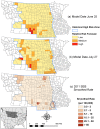Remote sensing of climatic anomalies and West Nile virus incidence in the northern Great Plains of the United States
- PMID: 23071656
- PMCID: PMC3465277
- DOI: 10.1371/journal.pone.0046882
Remote sensing of climatic anomalies and West Nile virus incidence in the northern Great Plains of the United States
Abstract
The northern Great Plains (NGP) of the United States has been a hotspot of West Nile virus (WNV) incidence since 2002. Mosquito ecology and the transmission of vector-borne disease are influenced by multiple environmental factors, and climatic variability is an important driver of inter-annual variation in WNV transmission risk. This study applied multiple environmental predictors including land surface temperature (LST), the normalized difference vegetation index (NDVI) and actual evapotranspiration (ETa) derived from Moderate-Resolution Imaging Spectroradiometer (MODIS) products to establish prediction models for WNV risk in the NGP. These environmental metrics are sensitive to seasonal and inter-annual fluctuations in temperature and precipitation, and are hypothesized to influence mosquito population dynamics and WNV transmission. Non-linear generalized additive models (GAMs) were used to evaluate the influences of deviations of cumulative LST, NDVI, and ETa on inter-annual variations of WNV incidence from 2004-2010. The models were sensitive to the timing of spring green up (measured with NDVI), temperature variability in early spring and summer (measured with LST), and moisture availability from late spring through early summer (measured with ETa), highlighting seasonal changes in the influences of climatic fluctuations on WNV transmission. Predictions based on these variables indicated a low WNV risk across the NGP in 2011, which is concordant with the low case reports in this year. Environmental monitoring using remote-sensed data can contribute to surveillance of WNV risk and prediction of future WNV outbreaks in space and time.
Conflict of interest statement
Figures




References
-
- Petersen LR, Hayes EB (2004) Westward ho?–The spread of West Nile virus. N Engl J Med 351: 2257–2259. - PubMed
-
- Lindsey NP, Staples JE, Lehman JA, Fischer M (2010) Surveillance for human West Nile virus disease - United States, 1999–2008. MMWR Surveill Summ 59: 1–17. - PubMed
-
- Lindsey NP, Kuhn S, Campbell GL, Hayes EB (2008) West Nile virus neuroinvasive disease incidence in the United States, 2002–2006. Vector Borne Zoonotic Dis 8: 35–39. - PubMed
Publication types
MeSH terms
Grants and funding
LinkOut - more resources
Full Text Sources
Medical

